Divergent Drought Paradigms and Their Driving Mechanisms in the Yangtze and Yellow River Basins
Abstract
1. Introduction
2. Materials and Methods
2.1. Study Area and Data
2.2. Standardized Precipitation Index (SPI)
2.3. Standardized Precipitation Evapotranspiration Index (SPEI)
2.4. Palmer Drought Severity Index (PDSI)
2.5. Vapor Pressure Deficit (VPD)
3. Results
3.1. Spatiotemporal Distribution and Long-Term Trends of Drought
3.2. Seasonal Differences in Drought
3.3. VPD Atmospheric Evaporative Demand Response During Droughts
3.4. Identification of Large-Scale Drivers of Drought
4. Discussion
4.1. Differences in Drought Patterns Between the Yangtze River Basin and the Yellow River Basin
4.2. Contribution of Precipitation Deficits and Atmospheric Evaporative Demand to Drought
4.3. Causal Mechanisms and Implications of Drought Differences Between the Basins
5. Conclusions
- The two basins exhibit significant and systematic disparities in the spatiotemporal evolution and seasonal characteristics of drought. In terms of temporal evolution, the hydroclimatic conditions in the Yangtze River Basin are characterized by high-frequency interannual fluctuations with a relatively stable long-term trend. In contrast, the Yellow River Basin has undergone a profound decadal shift, transitioning from a state of persistent drought in the 20th century to significant wetting in the 21st century. Spatially, the climatologically drought-prone areas in the Yangtze River Basin are primarily concentrated in the upstream headwaters, whereas in the Yellow River Basin, they are located in the Loess Plateau of the middle reaches. As clearly illustrated in our analysis (Figure 6), seasonal comparisons further accentuate these differences: drought intensity is higher and the area affected by PDSI is larger in the Yellow River Basin, especially in summer and autumn, while the drought frequency is systematically higher in the Yangtze River Basin.
- The differences in drought event characteristics are rooted in distinct physical processes. Droughts in the Yangtze River Basin are characterized by “high-frequency, short-duration, and high-intensity” events. Its humid climatic background dictates that the basin’s hydrological system is extremely sensitive to short-term meteorological fluctuations, which prevents the effective accumulation of drought impacts and results in a weak soil moisture memory effect. In contrast, droughts in the Yellow River Basin are characterized by “low-frequency, long-duration” events. This is closely related to its stronger soil moisture memory effect under a semi-arid climate, where the impact of a single moisture deficit event lingers longer in the soil, allowing the drought process to accumulate and propagate over time.
- The role of the thermal factor in drought formation shows a significant regional divergence. Quantitative attribution analysis reveals, based on a multiple linear regression model using standardized variables, that drought in the Yangtze River Basin is typically “moisture-driven,” with the formation of short-term droughts almost entirely dependent on precipitation deficits. In the Yellow River Basin, however, the contribution of VPD to drought formation is substantially higher, making it a distinctly “hydrothermal composite” system, where VPD contributes over 20% to the variance of long-term soil drought. This finding quantitatively confirms the high sensitivity of the Yellow River Basin to thermal conditions and reveals that warming has become a key amplifying factor in exacerbating drought severity in the basin.
- Droughts in the two basins respond to different large-scale climate systems. The drought conditions in the Yangtze River Basin primarily respond to the Atlantic and high-latitude circulation systems that modulate East Asian moisture transport. In contrast, drought in the Yellow River Basin is highly coupled with external forcing factors such as solar activity and ENSO, which can simultaneously influence both water and thermal conditions. This dichotomy has critical implications for water resource management. For example, long-range drought forecasts for the Yangtze could be improved by incorporating AMO phase predictions, while seasonal to interannual water allocation strategies in the water-scarce Yellow River Basin should closely monitor ENSO forecasts and solar cycle activity to anticipate potential shifts in water availability.
Author Contributions
Funding
Data Availability Statement
Conflicts of Interest
References
- Intergovernmental Panel on Climate Change. Climate Change 2022–Impacts, Adaptation and Vulnerability: Working Group II Contribution to the Sixth Assessment Report of the Intergovernmental Panel on Climate Change; Cambridge University Press: Cambridge, UK, 2023. [Google Scholar] [CrossRef]
- Walsh, J.E.; Ballinger, T.J.; Euskirchen, E.S.; Hanna, E.; Mard, J.; Overland, J.E.; Tangen, H.; Vihma, T. Extreme weather and climate events in northern areas: A review. EARTH-Sci. Rev. 2020, 209, 103324. [Google Scholar] [CrossRef]
- Cook, B.I.; Mankin, J.S.; Anchukaitis, K.J. Climate Change and Drought: From Past to Future. Curr. Clim. Change Rep. 2018, 4, 164–179. [Google Scholar] [CrossRef]
- Spinoni, J.; Naumann, G.; Vogt, J.V.; Barbosa, P. The biggest drought events in Europe from 1950 to 2012. J. Hydrol. Reg. Stud. 2015, 3, 509–524. [Google Scholar] [CrossRef]
- Cook, B.I.; Mankin, J.S.; Marvel, K.; Williams, A.P.; Smerdon, J.E.; Anchukaitis, K.J. Twenty-First Century Drought Projections in the CMIP6 Forcing Scenarios. Earth’s Future 2020, 8, e2019EF001461. [Google Scholar] [CrossRef]
- Mishra, A.K.; Singh, V.P. A review of drought concepts. J. Hydrol. 2010, 391, 204–216. [Google Scholar] [CrossRef]
- Yuan, W.; Zheng, Y.; Piao, S.; Ciais, P.; Lombardozzi, D.; Wang, Y.; Ryu, Y.; Chen, G.; Dong, W.; Hu, Z.; et al. Increased atmospheric vapor pressure deficit reduces global vegetation growth. Sci. Adv. 2019, 5, eaax1396. [Google Scholar] [CrossRef]
- Chen, F.; Xu, Q.; Chen, J.; Birks, H.J.B.; Liu, J.; Zhang, S.; Jin, L.; An, C.; Telford, R.J.; Cao, X.; et al. East Asian summer monsoon precipitation variability since the last deglaciation. Sci. Rep. 2015, 5, 11186. [Google Scholar] [CrossRef]
- Huang, J.; Yu, H.; Guan, X.; Wang, G.; Guo, R. Accelerated dryland expansion under climate change. Nat. Clim. Change 2015, 6, 166–171. [Google Scholar] [CrossRef]
- Xu, K.; Yang, D.; Yang, H.; Li, Z.; Qin, Y.; Shen, Y. Spatio-temporal variation of drought in China during 1961–2012: A climatic perspective. J. Hydrol. 2015, 526, 253–264. [Google Scholar] [CrossRef]
- Wang, A.; Lettenmaier, D.P.; Sheffield, J. Soil Moisture Drought in China, 1950–2006. J. Clim. 2011, 24, 3257–3271. [Google Scholar] [CrossRef]
- Piao, S.; Ciais, P.; Huang, Y.; Shen, Z.; Peng, S.; Li, J.; Zhou, L.; Liu, H.; Ma, Y.; Ding, Y.; et al. The impacts of climate change on water resources and agriculture in China. Nature 2010, 467, 43–51. [Google Scholar] [CrossRef]
- Varis, O.; Kummu, M.; Lehr, C.; Shen, D. China’s stressed waters: Societal and environmental vulnerability in China’s internal and transboundary river systems. Appl. Geogr. 2014, 53, 105–116. [Google Scholar] [CrossRef]
- Yu, M.; Liu, X.; Li, Q. Responses of meteorological drought-hydrological drought propagation to watershed scales in the upper Huaihe River basin, China. Environ. Sci. Pollut. Res. 2020, 27, 17561–17570. [Google Scholar] [CrossRef]
- Cai, W.; Li, K.; Liao, H.; Wang, H.; Wu, L. Weather conditions conducive to Beijing severe haze more frequent under climate change. Nat. Clim. Change 2017, 7, 257–262. [Google Scholar] [CrossRef]
- Liu, L.; Liu, Z.; Ren, X.; Fischer, T.; Xu, Y. Hydrological impacts of climate change in the Yellow River Basin for the 21st century using hydrological model and statistical downscaling model. Quat. Int. 2011, 244, 211–220. [Google Scholar] [CrossRef]
- Zhang, Q.; Gu, X.; Singh, V.P.; Kong, D.; Chen, X. Spatiotemporal behavior of floods and droughts and their impacts on agriculture in China. Glob. Planet. Change 2015, 131, 63–72. [Google Scholar] [CrossRef]
- Liu, Q.; Yang, Y.; Liang, L.; Jun, H.; Yan, D.; Wang, X.; Li, C.; Sun, T. Thresholds for triggering the propagation of meteorological drought to hydrological drought in water-limited regions of China. Sci. Total Environ. 2023, 876, 162771. [Google Scholar] [CrossRef] [PubMed]
- Liu, Q.; Liang, L.; Sun, T.; Wang, X.; Li, C.; Yan, S. Assessment of the shift in the precipitation-streamflow relationship influenced by multiyear drought, Yellow River basin, China. Sci. Total Environ. 2023, 903, 166203. [Google Scholar] [CrossRef] [PubMed]
- Vicente-Serrano, S.M.; Beguería, S.; López-Moreno, J.I. A Multiscalar Drought Index Sensitive to Global Warming: The Standardized Precipitation Evapotranspiration Index. J. Clim. 2010, 23, 1696–1718. [Google Scholar] [CrossRef]
- Sheffield, J.; Wood, E.F.; Roderick, M.L. Little change in global drought over the past 60 years. Nature 2012, 491, 435–438. [Google Scholar] [CrossRef]
- Sun, F.; Mejia, A.; Zeng, P.; Che, Y. Projecting meteorological, hydrological and agricultural droughts for the Yangtze River basin. Sci. Total Environ. 2019, 696, 134076. [Google Scholar] [CrossRef]
- Lu, J.; Qin, T.; Yan, D.; Zhang, X.; Jiang, S.; Yuan, Z.; Xu, S.; Gao, H.; Liu, H. Drought and wetness events encounter and cascade effect in the Yangtze River and Yellow River Basin. J. Hydrol. 2024, 639, 131608. [Google Scholar] [CrossRef]
- Bai, W.; Zhang, C.; Xiao, X.; Zou, Z.; Liu, Z.; Li, P.; Tang, J.; Li, T.; Zhou, X.; Peng, C. Characteristics of Meteorological Drought Evolution in the Yangtze River Basin. Water 2024, 16, 3391. [Google Scholar] [CrossRef]
- Tang, S.; Qiao, S.; Wang, B.; Liu, F.; Feng, T.; Yang, J.; He, M.; Chen, D.; Cheng, J.; Feng, G.; et al. Linkages of unprecedented 2022 Yangtze River Valley heatwaves to Pakistan flood and triple-dip La Niña. npj Clim. Atmos. Sci. 2023, 6, 44. [Google Scholar] [CrossRef]
- Jiang, L.; Gao, W.; Zhu, K.; Zheng, J.; Ren, B. Why Did the Extreme Drought in the Yangtze River Basin in 2022 Break the 2019 Record? Earth Space Sci. 2025, 12, e2024EA003972. [Google Scholar] [CrossRef]
- Chen, S.; Qiu, R.; Chen, Y.; Gong, W.; Han, G. Impacts of Drought and Heatwave on the Vegetation and Ecosystem in the Yangtze River Basin in 2022. Remote Sens. 2024, 16, 2889. [Google Scholar] [CrossRef]
- Duan, A.; Zhong, Y.; Xu, G.; Yang, K.; Tian, B.; Wu, Y.; Bai, H.; Hu, E. Quantifying the 2022 extreme drought in the Yangtze River Basin using GRACE-FO. J. Hydrol. 2024, 630, 130680. [Google Scholar] [CrossRef]
- Xiang, K.; Song, W.; Lu, J.; Zhao, A.; Lu, Y.; Feng, T.; Liu, H.; Gui, R.; Chen, L. Investigating the drought propagation dynamics between meteorological and groundwater drought in the Yellow River Basin, China. J. Hydrol. 2025, 660, 133446. [Google Scholar] [CrossRef]
- Xu, D.; Wang, M.; Zhang, Q.; Wu, S.; Zhang, L. Spatiotemporal characteristics and meteorological driving factors of flash droughts in the Yellow River Basin, China. Ecol. Indic. 2025, 177, 113745. [Google Scholar] [CrossRef]
- Li, Q.; Cao, Y.; Miao, S.; Huang, X. Spatiotemporal Characteristics of Drought and Wet Events and Their Impacts on Agriculture in the Yellow River Basin. Land 2022, 11, 556. [Google Scholar] [CrossRef]
- Ding, Y.; Zhang, L.; He, Y.; Cao, S.; Wei, X.; Guo, Y.; Ran, L.; Filonchyk, M. Spatiotemporal evolution of agricultural drought and its attribution under different climate zones and vegetation types in the Yellow River Basin of China. Sci. Total Environ. 2024, 914, 169687. [Google Scholar] [CrossRef]
- Cai, X. Water stress, water transfer and social equity in Northern China—Implications for policy reforms. J. Environ. Manag. 2008, 87, 14–25. [Google Scholar] [CrossRef]
- Liu, S.; Wang, D.; Wu, M.; Ma, Y.; Yang, Z.; Liu, X. Study on the Spatiotemporal Evolution of Evapotranspiration and the Integration of Multi-Source Data in the Water Source Area of the Middle Route of the South-to-North Water Transfer Project. Atmosphere 2025, 16, 396. [Google Scholar] [CrossRef]
- Shen, J.; Nie, Y.; Huang, X.; Ma, M. Comprehensive Assessment of Water Resource Carrying Capacity Based on Improved Matter–Element Extension Modeling. Water 2025, 17, 1197. [Google Scholar] [CrossRef]
- Chen, Y.; Yan, Y.; Zhu, T. Water Market Development in the Yellow River Basin: Challenges and Opportunities. Water 2024, 16, 894. [Google Scholar] [CrossRef]
- Zhou, C.; Wang, G.; Jiang, H.; Li, S.; Shi, X.; Hu, Y.; Cabral, P. Spatio-temporal patterns of compound dry-hot extremes in China. Atmos. Res. 2025, 314, 107795. [Google Scholar] [CrossRef]
- Wang, C.; Yao, Y.; Wang, H.; Sun, X.; Zheng, J. The 2020 Summer Floods and 2020/21 Winter Extreme Cold Surges in China and the 2020 Typhoon Season in the Western North Pacific. Adv. Atmos. Sci. 2021, 38, 896–904. [Google Scholar] [CrossRef]
- Jin, T.; Zhou, Y.; Zhou, P.; Zheng, Z.; Zhou, R.; Wei, Y.; Zhang, Y.; Jin, J. Spatiotemporal Evolution of Precipitation Concentration in the Yangtze River Basin (1960–2019): Associations with Extreme Heavy Precipitation and Validation Using GPM IMERG. Remote Sens. 2025, 17, 2732. [Google Scholar] [CrossRef]
- Xu, K.; Zhu, C.; He, J. Linkage between the dominant modes in Pacific subsurface ocean temperature and the two type ENSO events. Chin. Sci. Bull. 2012, 57, 3491–3496. [Google Scholar] [CrossRef]
- Wang, B.; Wu, R.; Fu, X. Pacific–East Asian Teleconnection: How Does ENSO Affect East Asian Climate. J. Clim. 2000, 13, 1517–1536. [Google Scholar] [CrossRef]
- Mckee, T.B.; Doesken, N.J.; Kleist, J.R. The relationship of drought frequency and duration to time scales. In Proceedings of the 8th Conference on Applied Climatology, Anaheim, CA, USA, 17–22 January 1993. [Google Scholar]
- Hayes, M.; Svoboda, M.; Wall, N.; Widhalm, M. The Lincoln Declaration on Drought Indices: Universal Meteorological Drought Index Recommended. Bull. Am. Meteorol. Soc. 2011, 92, 485–488. [Google Scholar] [CrossRef]
- Guttman, N.B. Accepting the standardized precipitation index: A calculation algorithm. JAWRA J. Am. Water Resour. Assoc. 1999, 35, 311–322. [Google Scholar] [CrossRef]
- Allan, R.; Pereira, L.; Smith, M. Crop Evapotranspiration-Guidelines for Computing Crop Water Rrequirements-FAO Irrigation and Drainage Paper 56; FAO: Rome, Italy, 1998; Volume 56. [Google Scholar]
- Palmer, W. Meteorological Drought; Research Paper No. 45; US Department of Commerce, Weather Bureau: Silver Spring, MD, USA, 1965; 58p.
- Zhong, R.; Chen, X.; Lai, C.; Wang, Z.; Lian, Y.; Yu, H.; Wu, X. Drought monitoring utility of satellite-based precipitation products across mainland China. J. Hydrol. 2019, 568, 343–359. [Google Scholar] [CrossRef]
- GB/T 20481-2006; Classification of Meteorological Drought. Standards Press of China: Beijing, China, 2006.


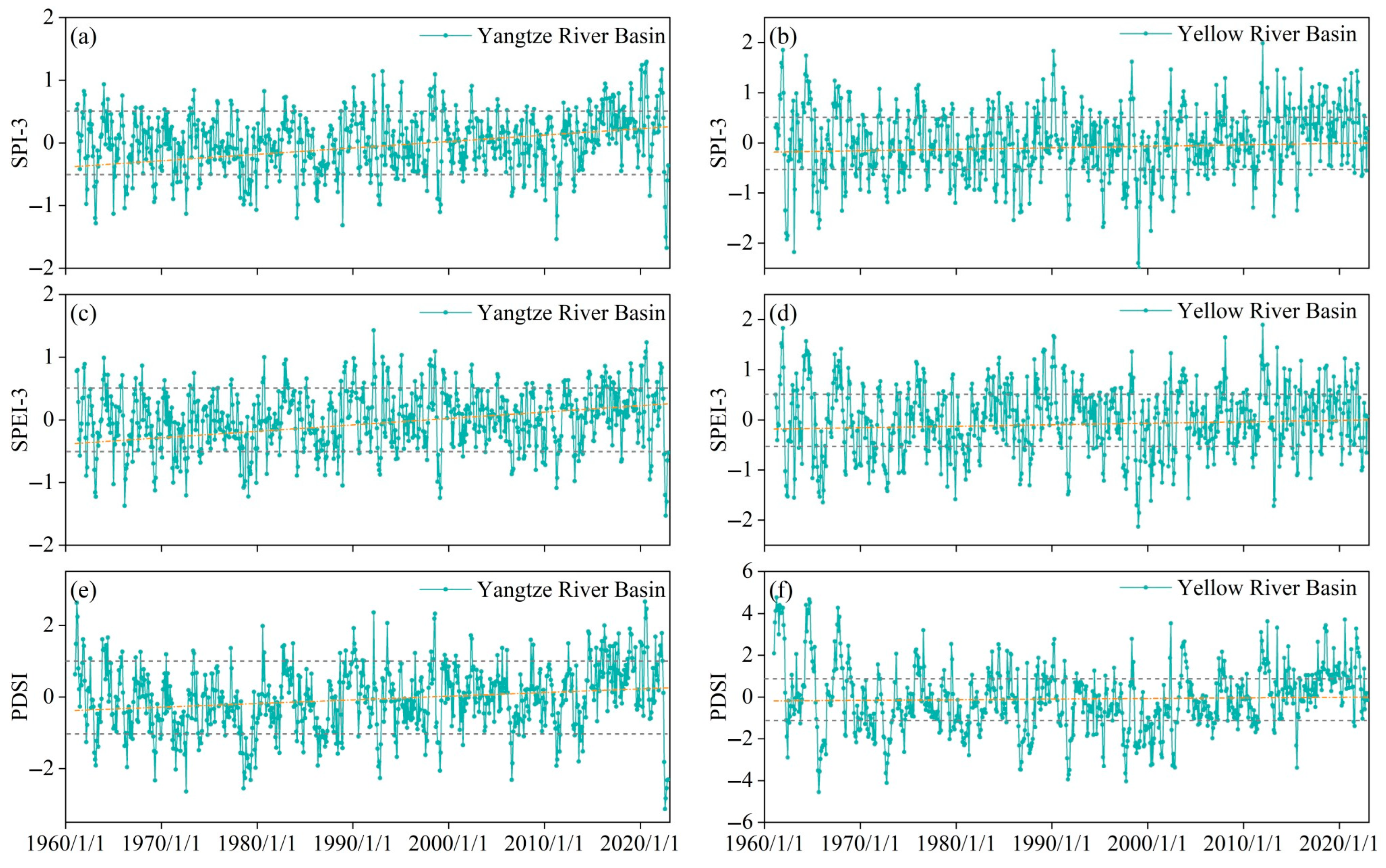
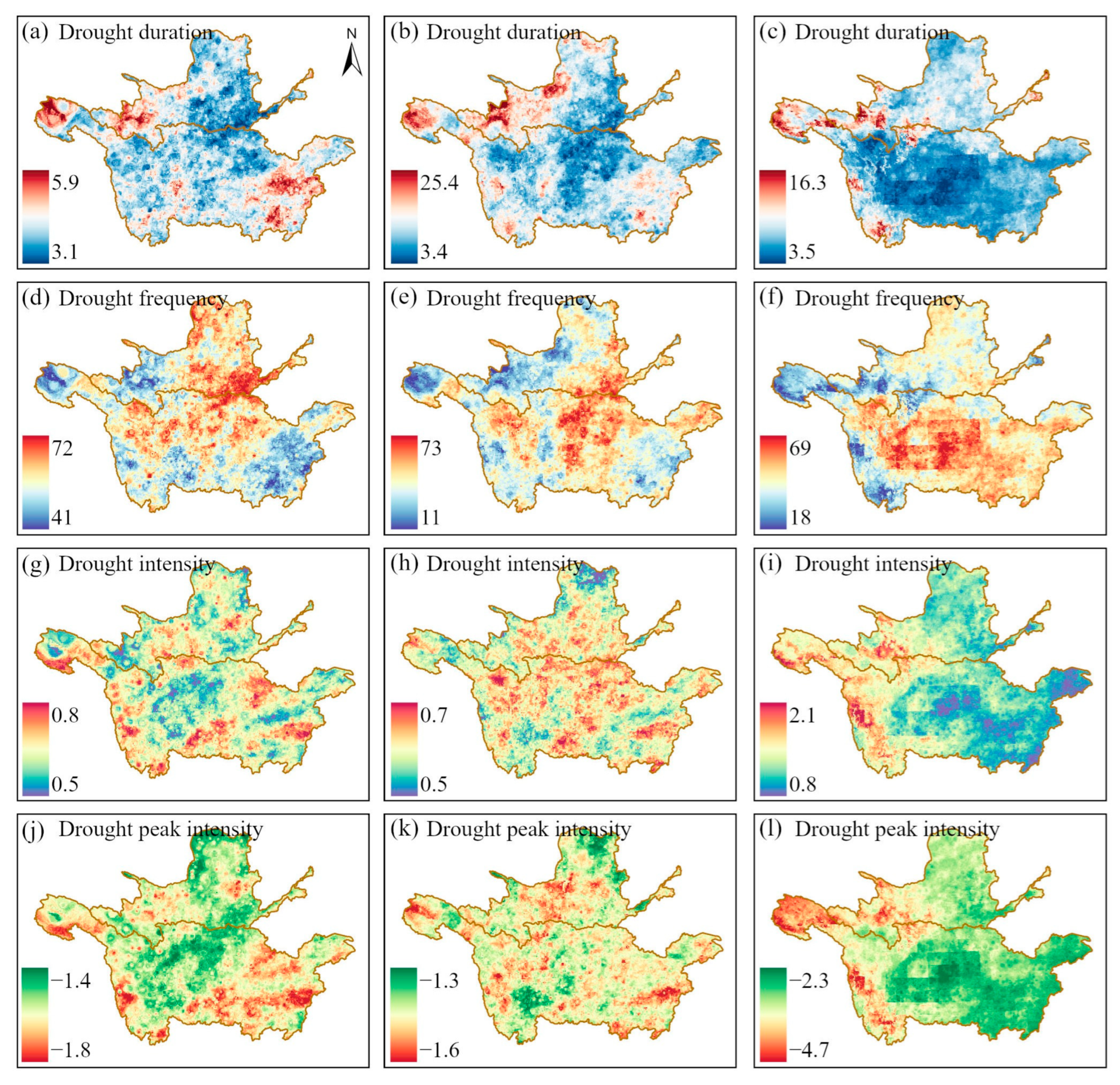

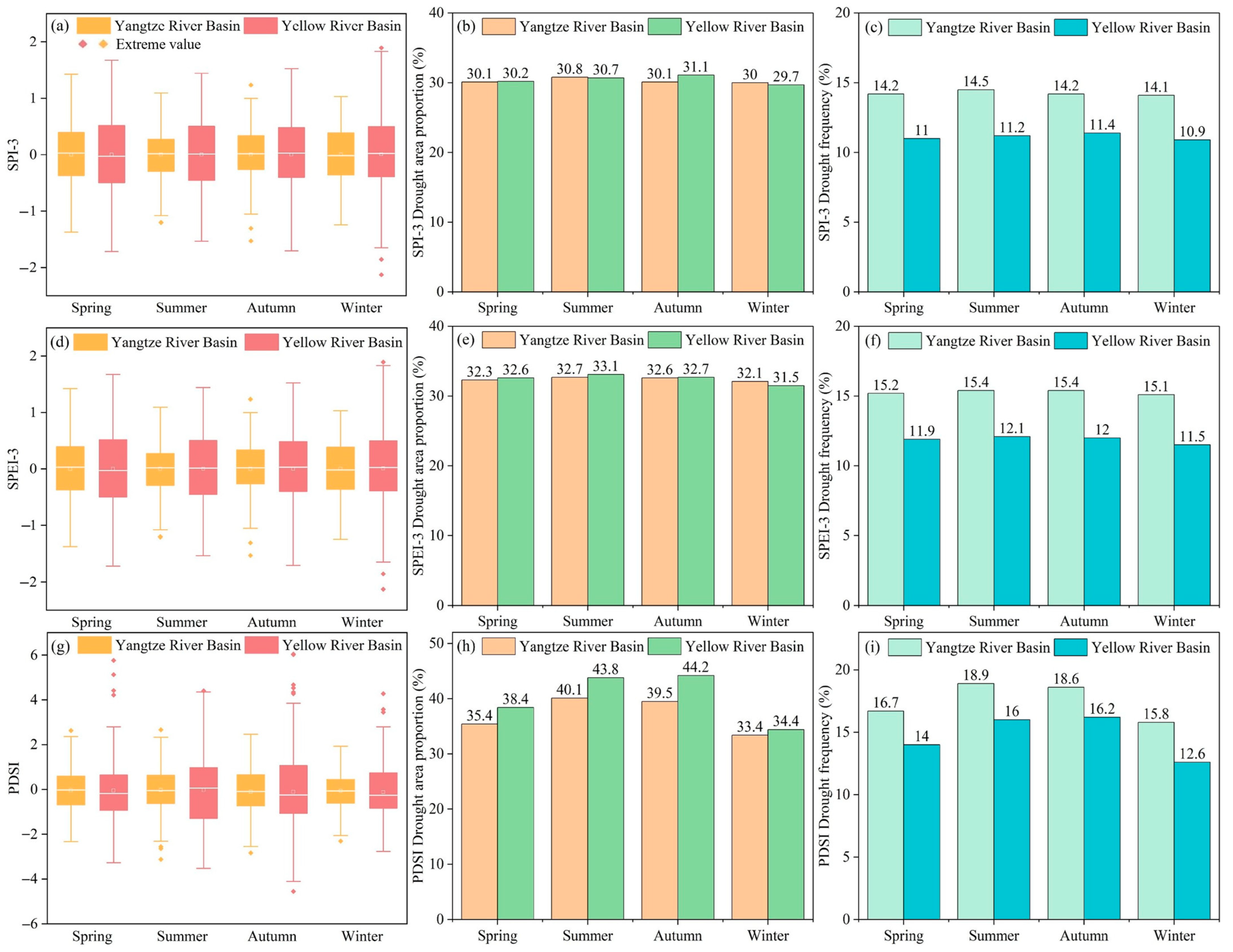

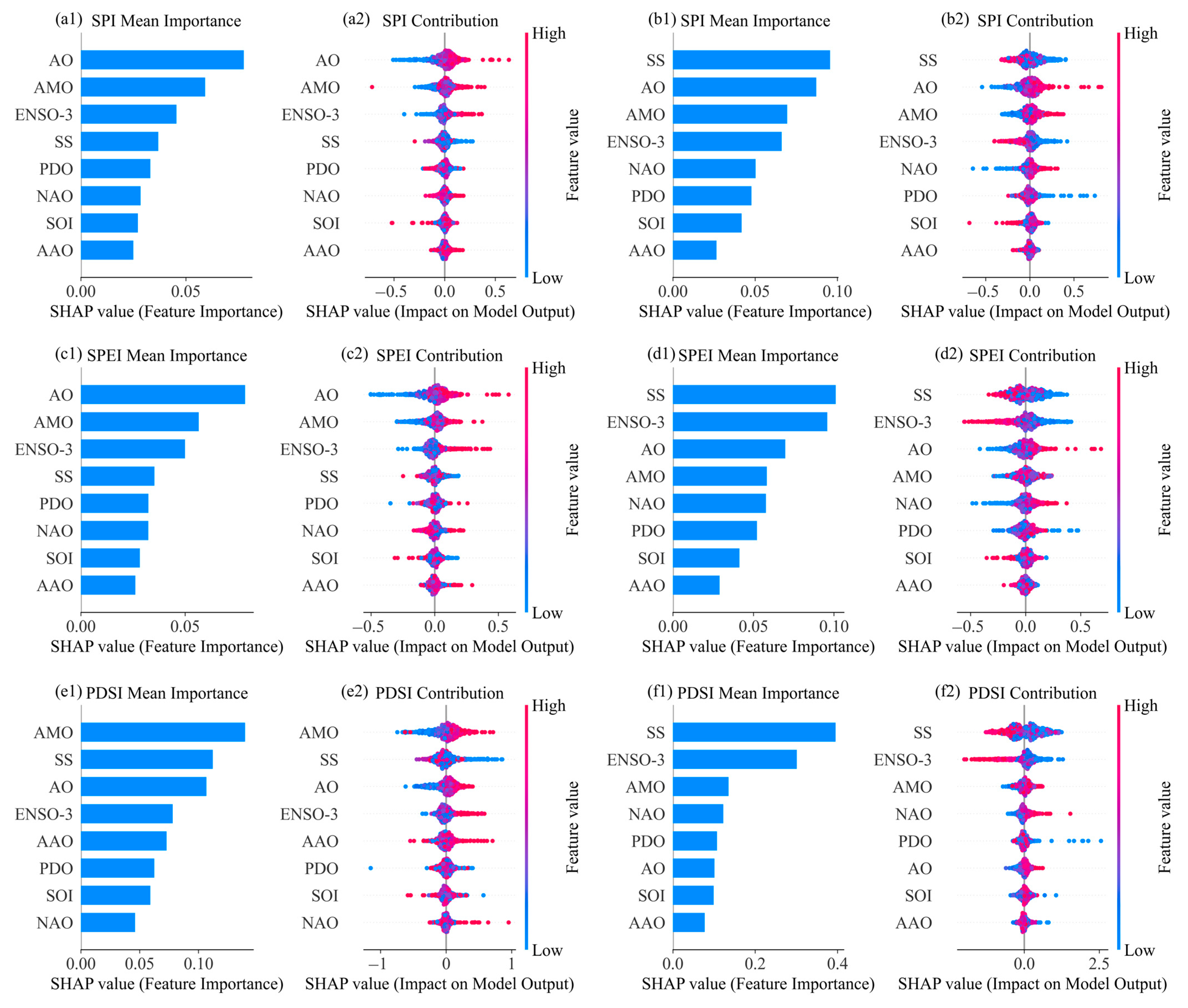
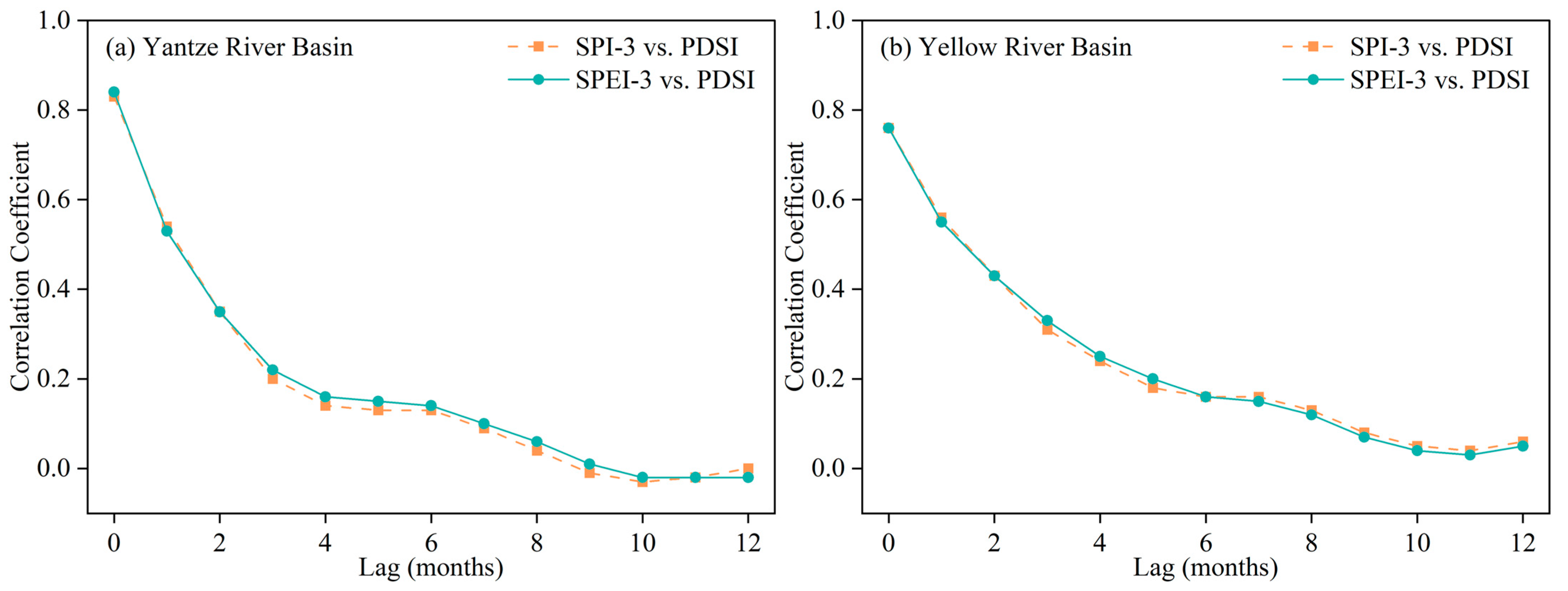
| Basin | SPI-3 Contribution (%) | VPD Anomaly Contribution (%) | ||
|---|---|---|---|---|
| SPEI-3 | PDSI | SPEI-3 | PDSI | |
| Yangtze River Basin | 95.65 | 85.57 | 4.35 | 14.43 |
| Yellow River Basin | 88.08 | 79.26 | 11.92 | 20.74 |
Disclaimer/Publisher’s Note: The statements, opinions and data contained in all publications are solely those of the individual author(s) and contributor(s) and not of MDPI and/or the editor(s). MDPI and/or the editor(s) disclaim responsibility for any injury to people or property resulting from any ideas, methods, instructions or products referred to in the content. |
© 2025 by the authors. Licensee MDPI, Basel, Switzerland. This article is an open access article distributed under the terms and conditions of the Creative Commons Attribution (CC BY) license (https://creativecommons.org/licenses/by/4.0/).
Share and Cite
Yang, L.; Wang, T.; Li, H.; Wang, D.; Wang, Y.; Zhang, H.; Wu, X. Divergent Drought Paradigms and Their Driving Mechanisms in the Yangtze and Yellow River Basins. Water 2025, 17, 3030. https://doi.org/10.3390/w17213030
Yang L, Wang T, Li H, Wang D, Wang Y, Zhang H, Wu X. Divergent Drought Paradigms and Their Driving Mechanisms in the Yangtze and Yellow River Basins. Water. 2025; 17(21):3030. https://doi.org/10.3390/w17213030
Chicago/Turabian StyleYang, Lan, Tingting Wang, He Li, Dejian Wang, Yanfang Wang, Hui Zhang, and Xinjia Wu. 2025. "Divergent Drought Paradigms and Their Driving Mechanisms in the Yangtze and Yellow River Basins" Water 17, no. 21: 3030. https://doi.org/10.3390/w17213030
APA StyleYang, L., Wang, T., Li, H., Wang, D., Wang, Y., Zhang, H., & Wu, X. (2025). Divergent Drought Paradigms and Their Driving Mechanisms in the Yangtze and Yellow River Basins. Water, 17(21), 3030. https://doi.org/10.3390/w17213030





